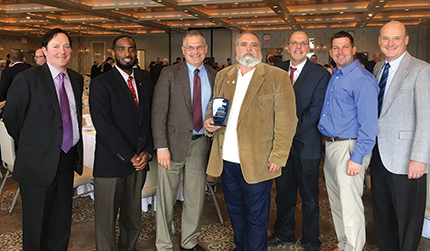
Dean Audet, Fuss & O’Neill; Kevin McGee, Town of Coventry;
Bob Joyal, Town of Coventry; Sean Arruda, Fuss & O’Neill; and Stu Harris, Fuss & O’Neill.
Coventry, RI Fuss & O’Neill has received the National APWA (American Public Works Association) award for Disaster/ Emergency Construction Repair for the Pawtuxet River Flood Resiliency project.
The project received the award in the Small Cities/Rural Communities- Disaster/ Emergency category. This award honors agencies representing cities and communities with a population of 75,000 or less that include the techniques and timing for safety, community relations, environmental protection, adverse conditions and additional considerations.
During the spring of 2010, over eight inches of rain fell on the Pawtucket river watershed. Combined with the 11.3 inches of rainfall over the previous 35 days and the level of impervious surfaces in central Rhode Island, a historic flooding event occurred. This caused substantial flooding and damage throughout the Pawtucket River.
Fuss & O’Neill was brought into this project as an effort to design and restore the in-river infrastructure in order to protect two historic buildings in Coventry: Concordia Fibers and Anthony Mills along with improving their resiliency to future flooding.
Funding came from the United States Department of Agriculture Natural Resources Conservation Service, the town of Coventry, and adjacent private property owners as part of a public private partnership to fund this project. NRCS agreed to cover 90% of the restoration costs and helped develop the sustainable plan that came to be.
This project was a great team effort, working with NRCS, the town of Coventry and private property owners to develop an innovative design that blends natural systems with traditional grey infrastructure in order to maximize resiliency to future floods while controlling project costs.
One of the innovative approaches in the Pawtuxet River Stabilization included micropile and tieback system to protect the Anthony Mill clock tower from future scour in the river as well as reduce construction risks from destabilizing the tower by disturbing the existing foundation materials and soils. Another approach was the use of stone arch weirs and stream barbs in the river to control elevation changes, reduce velocities within the river and direct erosive velocities away from critical infrastructure and into the center of the river. These also improved habitat value in this urban river as they were constructed using natural rock to provide shelter for fish and other aquatic organisms.
Those who worked on the project will receive their award at the APWA Awards Recognition Ceremony in conjunction with the 2017 PWX Convention in Orlando on August 28th at the Orlando Orange County Convention Center.
.png)






